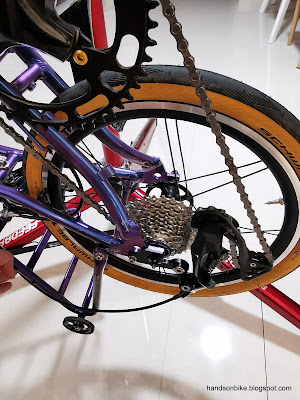With the rear derailleur and hanger on the United Trifold installed successfully, next is to try an 11 speed cassette on the wheelset. Thankfully for the standard 135 mm rear OLD, a standard wheelset and freehub body can be used, which makes things so much easier. Still, I think I am speaking too early to declare this derailleur drivetrain conversion project a success.
Took a picture of the single speed setup, before I disassembled it.
The reason I used an 11 speed R7000 rear derailleur, is mainly because I have other compatible 11 speed components available as well. For example, I have this Ultegra R8000 11-30T 11 speed cassette sitting around as a spare. I think it was previously used on the Dahon MuSP, which is now using a 11-32T cassette instead.
I was already using an 11 speed chain on the single speed drivetrain, and also had an 11 speed SL-RS700 shifter available, so the easiest way to try out this derailleur drivetrain is to make it a 1x11 speed setup.
Ultegra R8000 11-30T 11 speed cassette. Check out this link for a detailed comparison with the Dura-Ace version.
11-30T spec clearly labelled on the largest sprocket spider.
Here is how it looks! Reminds me of the time I built the Fnhon Gust, with a similarly sized cassette and wheels.
Before installing other components, I wanted to see how the cassette would interact with the rear derailleur. I have two main concerns for this derailleur conversion.
The first is the chain management when folded. Due to the nature of the trifold method, the chain stay length reduces when the bike is folded. The excess chain thus needs to be absorbed or tensioned to prevent it from becoming slack. Without a proper chain tensioner, there may be problems.
Second problem is the ground clearance. With a mid cage rear derailleur, there would be very little clearance with the ground, when used on a small 349 16 inch wheel. Still, I wanted to give it a go and see what problems I will face.
To minimize the amount of excess chain, I made the chain as short as I dared. See how stretched the rear derailleur cage is.
I attached the shifter temporarily to the rear derailleur as shown, just to shift it across the cassette.
First sign of trouble. With the rear triangle only half folded (hanging straight down), the chain tension is already lost.
The rear derailleur cage is already fully retracted, and cannot tension any more chain.
If the rear triangle is folded fully, the chain becomes slack as shown.
I have seen chain tensioners (used on Birdy folding bikes) that attach to the end of the derailleur cage, adding extra capacity to the rear derailleur when folded.
Another problem that I did not foresee was chain interference with the frame. As mentioned earlier, due to the compact nature of the trifold frame design, non-standard modifications are never straightforward.
Chain interferes with the seat stay when at the smallest 11T sprocket.
Pedaling is still possible, but the chain would grind away the paint on the frame and makes a noise.
At the lowest gear (30T largest sprocket) of the cassette, the chain interferes with the semi-circle loop that is welded onto the seat stay. This loop is for routing the rear brake cable (which I have already moved it out as shown).
Again, pedaling is possible, but with a grinding noise. Not acceptable for me.
When the chain is moved outwards to the second largest sprocket (27T), there is no frame interference.
The chain barely clears the frame, on the 27T sprocket.
Based on these findings, I decided to use the rear derailleur limit screws to lock out the lowest gear (30T, or gear 1) and the highest gear (11T, or gear 11). This will prevent accidental shifting into these extreme gears by accident.
It is a bit tricky to setup, but I wanted to bring the bike out for a test ride, which is why this is a temporary solution. The gear range is thus limited to 12-27T 9 speeds, which is not ideal but way better than the previous single speed. Coincidentally, this 12-27T gear range is the same as the cassette that I had on the Dahon Boardwalk, more than 10 years ago!
I also noticed other potential issues, as shown below.
Rear derailleur cage goes really close to the tire!
This is due to the small wheel size, and also the relatively long mid cage rear derailleur.
During the test ride, I heard a scraping sound as I went past a small step. I backtracked a little and found what happened.
The cage is too close to the ground! Although the chain and tire is able to make it up the step with no issue, the cage scraped the ground.
Due to the uneven ground, the tire made it up smoothly, while the cage got caught on the step just beside it.
Apart from some scratches on the rear derailleur, not much harm done.
From this test ride, what I know is that this mid cage rear derailleur is not suitable. Yes from the start I knew that a short cage rear derailleur is definitely more ideal, but I did not have one available.
In any case, I know what to do next, in order to solve this ground clearance issue.





















No comments:
Post a Comment
Every comment is moderated before publishing due to spam bots. If you don't see your comment yet, it is likely that it is currently being reviewed. Thank you for your patience!